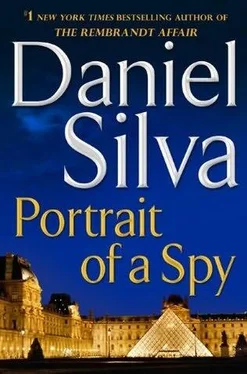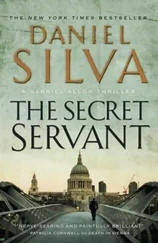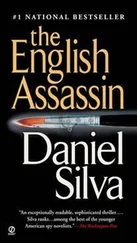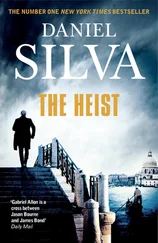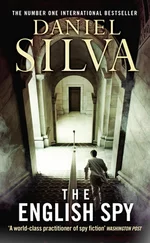Gabriel was silent. Isherwood reluctantly started walking again.
“I’ll never forget the day Shamron brought you into my gallery for the first time. You were so quiet, I wasn’t sure you could actually speak. Your temples were as gray as mine. Shamron called it—”
“The stain of a boy who’d done a man’s job.”
Isherwood smiled sadly. “When I saw you with a brush in your hand, I hated Shamron for what he’d done. He should have left you at Bezalel to finish your studies. You would have been one of your generation’s finest painters. As of this moment, everyone in New York is trying to figure out who painted that portrait of Nadia al-Bakari. I only wish they knew the truth.”
Isherwood paused again to gaze down at the waves beating against the black rocks at the northern end of the cove. “Come to work for me,” he said. “I’ll teach you the tricks of the trade, such as how to lose your shirt in ten easy steps or less. And when it’s time for me to devote my remaining energy to gardening, I’ll leave you with more than enough resources to carry on in my absence. It’s what I want, petal. More important, it’s what your wife wants.”
“It’s very generous, Julian, but I can’t accept.”
“Why not?”
“Because one day, an old enemy will make an appointment to see a Bordone or a Luini, and I’ll end up with several bullets in my head. And so will Chiara.”
“Your wife is going to be disappointed.”
“Better disappointed than dead.”
“Heaven knows I’m no expert when it comes to long-term relationships,” said Isherwood, “but I have a hunch your wife might be in need of a change of scenery.”
“Yes,” said Gabriel, smiling, “she’s made that abundantly clear.”
“So come to London, at least for the winter. It will give Chiara the distraction she needs, and it will save me a fortune in shipping fees. I have a panel by Piero di Cosimo that’s in desperate need of your attention. I’ll make it well worth your while.”
“Actually, I may have something in Rome.”
“Really?” asked Isherwood. “Public or private?”
“Private,” replied Gabriel. “The owner lives in the very large house at the end of the Via della Conciliazione. He’s offering me a chance to clean one of my favorite pictures.”
“Which one?”
Gabriel answered.
“I’m afraid I can’t compete with that,” Isherwood said. “Is he going to pay you anything?”
“Acorns,” said Gabriel, “but it will be worth it. For Chiara’s sake, if nothing else.”
“Just try to stay out of trouble while you’re there. The last time you were in town . . .”
Isherwood stopped himself. It was clear from Gabriel’s expression he no longer wished to dwell on the past.
The wind had torn a hole in the veil of clouds, and the sun was hovering just above the sea like a white disk. They remained atop the cliffs a moment longer, until the sun was gone, then started toward home. As they entered the cottage, they could hear Chiara singing. It was one of those silly Italian pop songs she always sang when she was happy.
P ORTRAIT OF A SPY IS a work of fiction. The names, characters, places, and incidents portrayed in the story are the product of the author’s imagination or have been used fictitiously. Any resemblance to actual persons, living or dead, businesses, companies, events, or locales is entirely coincidental.
The Madonna and Child with Mary Magdalene portrayed in the novel does not exist. If it did, it would bear a striking resemblance to a similar painting by Tiziano Vecellio, also known as Titian, that hangs in the State Hermitage Museum in Saint Petersburg, Russia. Lot 12, Ocher and Red on Red , oil on canvas, by Mark Rothko, is also fictitious, though in May 2007, a similar painting, White Center (Yellow, Pink and Lavender on Rose) , fetched $72.84 million at auction in New York, a record for the artist. According to published reports, the buyer was the ruler of Qatar.
The art dealers, auctioneers, and consultants who appear in the novel, along with other books in the series, were created by the author and are in no way meant to be construed as fictitious renderings of real people. There is indeed an enchanting art gallery at 7–8 Mason’s Yard in London, though its owner, the inimitable Patrick Matthiesen, shares nothing with Julian Isherwood other than his warmth and brilliant wit. The techniques for the restoration and relining of paintings described in the novel are accurate, including the speed with which a gifted restorer, if necessary, could knock a picture into shape. Deepest apologies to the management of Christie’s in London for using an Old Master auction to fund a terrorist network, but I’m afraid operational security required keeping the affair secret.
Students of the global war on terror will no doubt recognize that, in creating the character Rashid al-Husseini, I have borrowed much from the curriculum vitae of the American-born al-Qaeda cleric and recruiter Anwar al-Awlaki—including his Yemeni background, his disturbing connection to two of the 9/11 hijackers in San Diego and Northern Virginia, and his apparent journey from moderation to radicalism and terror. The fictitious Malik al-Zubair was also inspired by real terror masterminds—namely, Yahya Ayyash, the Hamas master bomb-maker known as “the Engineer,” and Abu Musab al-Zarqawi, the Jordanian terrorist who led al-Qaeda in Iraq. Ayyash was killed in January 1997 by a small bomb concealed in a cellular phone. Zarqawi, who was responsible for the death of hundreds of innocent Iraqis during the bloodiest phase of the Iraq insurgency, was killed in an American air strike on a safe house north of Baghdad in June 2006.
The border crossing between the United Arab Emirates and Saudi Arabia described in the novel does not exist. The actual crossing is many miles to the north and in recent months has been prone to long backups due to changes in Saudi customs procedures. The spectacular rise and fall of Dubai has been faithfully portrayed, along with the deplorable treatment of its large foreign workforce. Unfortunately, Dubai is not the only Gulf emirate where foreign workers are routinely abused and treated as virtual indentured servants. In March 2011, the Guggenheim Museum under construction in neighboring Abu Dhabi faced a threatened boycott by more than a hundred prominent artists who were outraged over conditions at the site. “Those working with bricks and mortar,” the Lebanese-born media artist Walid Raad said in a statement, “deserve the same kind of respect as those working with cameras and brushes.”
Financial intelligence, or “finint,” has been an important weapon in the war on terror for many years now. The Treasury Department’s Office of Terrorism and Financial Intelligence collects and analyzes transactional data, as does the FBI’s Terrorist Financing Operations Section. In addition, the CIA and numerous private companies connected to the vast American national-security complex all routinely track the flow of money through the bloodstream of the global jihadist movement.
Regrettably, a decade after the attacks of 9/11, much of this money still comes from the citizens of Saudi Arabia and, to a lesser extent, the Sunni Muslim emirates of the Persian Gulf. In a secret cable made public in December 2010, Secretary of State Hillary Clinton wrote, “It has been an ongoing challenge to persuade Saudi officials to treat terrorist financing emanating from Saudi Arabia as a strategic priority.” In conclusion, Clinton’s memo declares that “donors in Saudi Arabia constitute the most significant source of funding to Sunni terrorist groups worldwide.”
One would think that Saudi Arabia, the country that produced Osama Bin Laden and fifteen of the nineteen 9/11 hijackers, would do more to clamp down on terrorist fund-raising on its soil. But other diplomatic cables have revealed the House of Saud has been unable or unwilling to shut down the flow of money to al-Qaeda and its affiliates. Militant groups operate front charities inside Saudi Arabia with impunity or simply solicit cash donations openly during the annual Hajj pilgrimage to Mecca. Prince Mohammad Bin Nayef, leader of Saudi Arabia’s counterterrorism efforts, told a senior American official that “we are trying to do our best” to stem the flow of cash to extremists and murderers. But, he added, “if money wants to go” to terrorists, there is little Saudi authorities can do to stop it.
Читать дальше
Конец ознакомительного отрывка
Купить книгу
